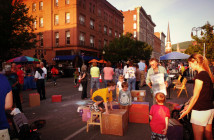The Berkshires are well-known in Boston and New York for incredible natural beauty as well as a vibrant arts and culture scene. Mount Greylock is the highest point in the Commonwealth of Massachusetts at approximately 3500 feet, and overlooks the former industrial towns of North Adams, Cheshire and Pittsfield. These once-prosperous towns depended on manufacturing, a profitable industry due to the area’s proximity to the Hoosic and Housatonic rivers and an abundance of cheap labor. The switch of industry in the USA during the 1970s and 1980s from manufacturing to service greatly affected towns in the Berkshires and throughout the USA, which depended largely on manufacturing. North Adams, Pittsfield and similar towns in the Berkshires were greatly affected with a depressed economic base, population flight and developmental collapse. Driving through these cities, one still sees empty storefronts. However, the number of vacant businesses has decreased in recent years with the use of cultural and creative industries which have revitalized the economy.
Creative Placemaking is a recent buzzword, suddenly being used liberally by those in the cultural industry. The NEA defines it as "when partners from public, private, non-profit, and community sectors strategically shape the physical and social character of a neighborhood, town, city, or region around arts and cultural activities. Creative Placemaking animates public and private spaces, rejuvenates structures and streetscapes, improves local business viability and public safety, and brings diverse people together to celebrate, inspire, and be inspired." This summer, I am engaged in these theoretical discussions, as part of the Massachusetts College of Liberal Arts’ Berkshire Hills Internship Program (B-HIP), for which I am interning at the City of Pittsfield, Office of Cultural Development; an office with a rare mission, i.e. to revitalize Downtown Pittsfield through arts and cultural initiatives.
In the laissez-faire United States, there is no Ministry of Culture, which sets the USA apart from other countries. Therefore, the existence of the Office of Cultural Development within this region of the USA brings up important questions as to government intervention and presentation of culture and its role in economic revitalization. Being a part of the creative economy, I certainly am of belief that arts have the potential to bring economic and social change, but how does one statistically document it?
During a conversation the Director of MassMOCA, Joseph Thompson, I asked him about some of the problems of using culture for economic revitalization (which is one of the stated missions of the museum). He pointed out that one of the specific expectations that the creative industry faces is job creation. The factory that sustained North Adams until 1985, Sprague Electric, employed 5000 people, most of them from the city. Today the population of North Adams is 15,000. In contrast, MassMOCA has a staff of up to 65, many of them not residents of the city, who hold advanced education degrees. There is clearly inherent tension in honoring both arts and the community while being true to both. Conversations with locals, while not representative of the general viewpoint, offer a different perspective. Inevitably, some question the need for arts and culture if they don’t create jobs. In my short experience so far, many college students in North Adams and the Berkshires don’t actually stay in the region after graduation, considering the area a dead-end, although this has started to change in the creative industry. Despite impressive efforts by organizations such as MassMOCA and Office of Cultural Development there is much more to be done, and balanced and it is this question that I hope to explore continuously throughout this summer.


